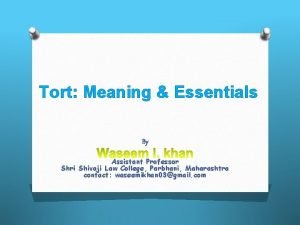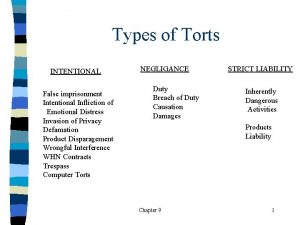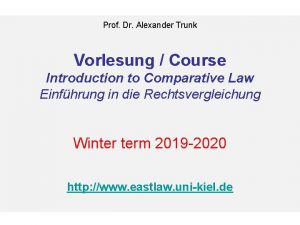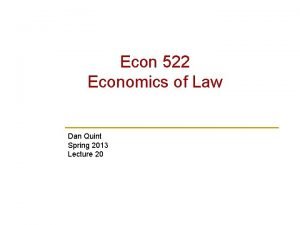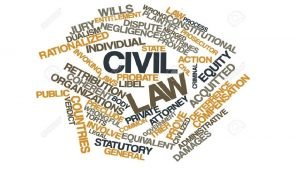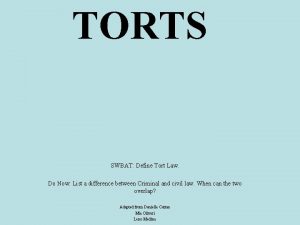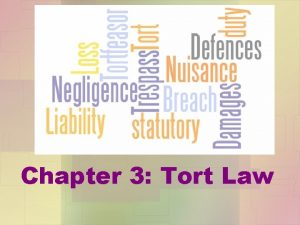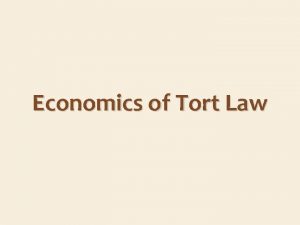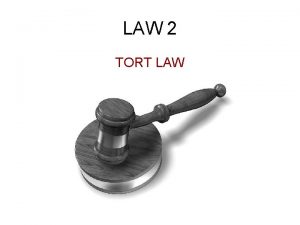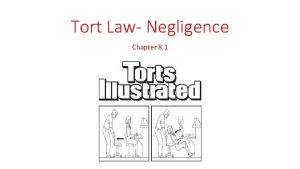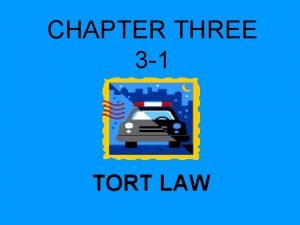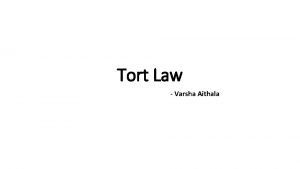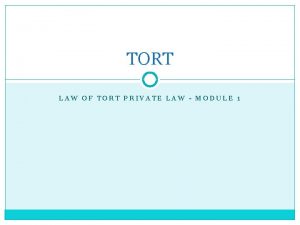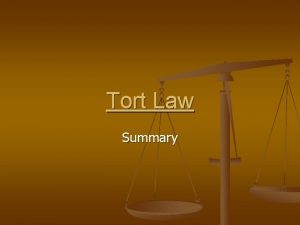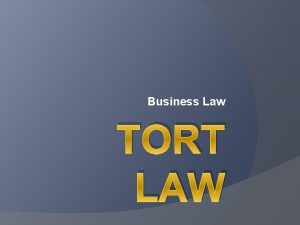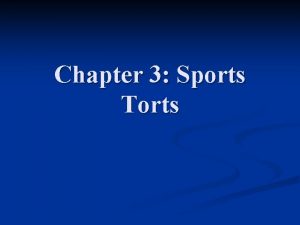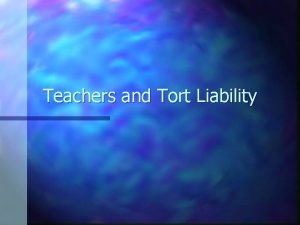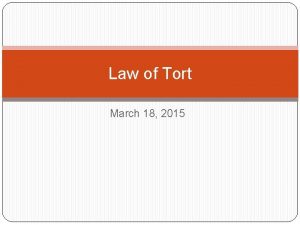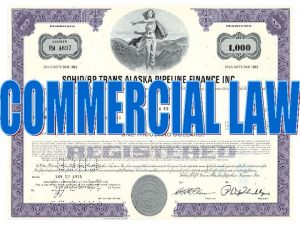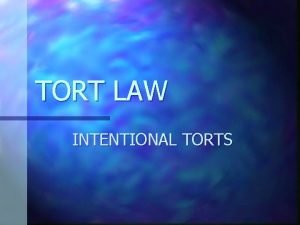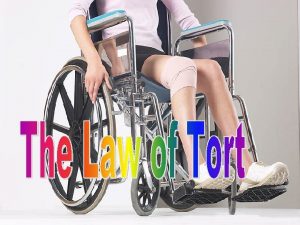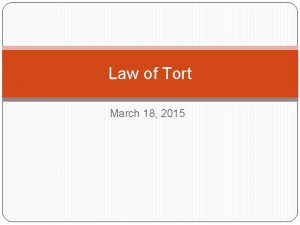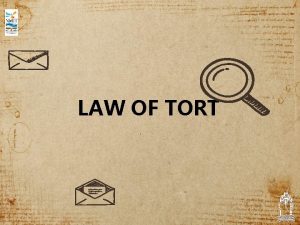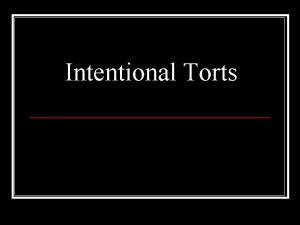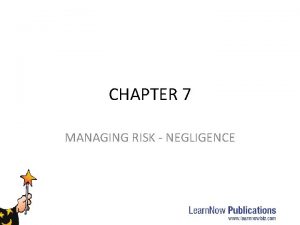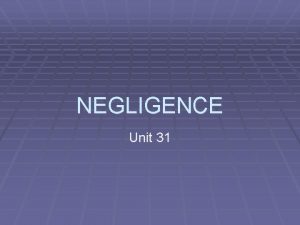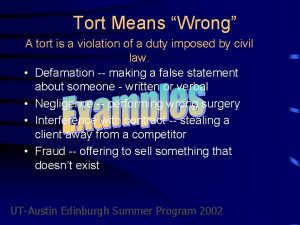Chapter 3 Tort Law Tort Wrongs for which










































































- Slides: 74

Chapter 3: Tort Law

Tort • Wrongs for which the wrongdoer can be sued. – A person who punches another person and injures them can be sued for the tort of battery – A doctor that performs a surgery on a patient and amputates the wrong leg can be sued for the tort of medical malpractice – A company that makes its employees work in unsafe conditions that result in the death of a worker can be sued for the tort of wrongful death

• Hypo 1: Someone broke into your car and took your ipod, your new jacket, and your backpack (with whatever might have been in there). – How should they be punished? • Hypo 2: Someone beat you up. – How should they be punished? • Hypo 3: Someone stole your identity, opened a credit card and bought a bunch of stuff under your name. Now you’re broke and your credit rating sucks, and debt collectors are calling your house. – How should they be punished?

Chapter 3 Outline • Rights of the individuals • Intentional and unintentional torts against persons & property • Concepts of liability, negligence, and risk

Tort • If one person interferes with the right of another person, a tort is involved. • Tort- comes from the Latin word torquere, which means “twisted” or “wrong”

Tort • A “wrong” may be committed intentionally or unintentionally. • The person who has been wronged has the right to seek compensation for injuries or damage. • The law of torts seeks to restore the injured person to the position he or she was in before the tort was committed. . . commonly called being “made whole”

Intentional vs. unintentional • Intentional – Causing damage or injury deliberately • Unintentional – Causing damage or injury through carelessness

Tort • Tort is based on the idea that everyone in our society has certain rights. – Right to walk around freely without being arrested – Right to privacy – Right to one’s good name and reputation • Everyone has the duty to respect the rights of others. • Tort law enforces those rights and duties.

Tort • Tort – Private wrong committed by one person against another. • Tortfeasor – A person who commits a tort – This person has interfered with another person’s rights.

Tortfeasor • There are 3 elements to any tort – 1. The possession of certain rights by an innocent party – 2. A violation of those rights by a tortfeasor – 3. A resulting injury that somehow hurts the person whose rights were violated. • Injured person= victim, innocent party, or plaintiff • Tortfeasor= defendant

Criminal Law • A wrong committed against the public good • Criminal wrong • Very serious penalties result Tort Law • A wrong committed against a particular person or property • A civil or private wrong • A tort can be a crime – Assault: hurts individual but poses a threat to all members of society

Remedies in Tort Law • Purpose is to compensate the victim for injuries caused by the tortfeasor. • Court makes the tortfeasor pay a fair amount of money– called damages– to the injured party (victim) • Damages: pain and suffering, medical expenses, replace (repair) damaged property, or pay for lost wages. • Punitive Damages= punish tortfeasor for serious crimes

Intentional Torts Against Persons • Actions that deliberately hurt, embarrass, or scare people. – Assault – Battery – False Imprisonment – Defamation – Invasion of privacy – Intentional infliction of emotional distress

Assault and Battery • Two separate torts, but can be committed together. • Assault – Threatening to harm an innocent person. – Assault occurs as soon as you’re afraid of immediate harm to your body – Example: Gun/knife pulled on you= assault

Assault and Battery • Battery – Unlawful, unwanted touching of another person – Battery is committed even if the physical contact is not harmful – Can be touching something closely associated with a person’s body such as a backpack or cap. – Example: Pulling a chair out from under someone before they sit down= battery

False Imprisonment • People have the right to move around freely. • If someone interferes with this right, then false imprisonment has occurred. • Example: A security guard in a store must have reasonable grounds to suspect shoplifting before they stop a customer.

Mc. Cann v. Wal-Mart Stores, Inc. • In December, 1996, Ms. Mc. Cann and two of her children were shopping at the Maine Wal-Mart store. After approximately an hour and a half, the Mc. Canns went to a register and paid for their purchases. As the Mc. Canns were leaving the store, two Wal-Mart employees, stepped out in front of the Mc. Canns’ shopping cart, blocking their path to the exit.

Mc. Cann v. Wal-Mart Stores, Inc. • The employees told Plaintiff that the children were not allowed in the store because they had been caught stealing on a prior occasion. Defendant’s employees had said they were calling the police, but actually called a store security officer to identify the earlier shoplifter. Eventually, the security officer, Rhonda Bickmore (Bickmore), arrived at the store and informed the employees that the Mc. Canns were not the family whose son had been caught shoplifting. The employees acknowledged their mistake to the Mc. Canns, and they left the store.

Defamation • Occurs when someone lies about another person in a way that hurts the innocent person’s reputation. • Two types: libel and slander

Defamation: Libel • Libel: lies about a person in written, printed, or recorded form. –Television shows, magazine stories, websites, or emails.

Defamation: Libel • Movie stars, famous athletes, and politicians have a hard time winning libel suits because the supreme court rules that public figures must prove that lies about them are told with actual malice. • Actual malice occurs when: – The defendant publishes a statement about the plaintiff he knows is false; or – The defendant publishes a statement about the plaintiff with reckless disregard for whether it is false or true.

Cameron Diaz Libel Case • Cameron Diaz won a libel case against British newspaper, the Sun, for accusing Diaz of having an affair with her friend, TV producer, Shane Nickerson. • Diaz was dating Justin Timberlake at the time and Nickerson was married with a child. The newspaper had run a blurred and shadowed picture, taken behind a bush, and stated that the two "enjoyed more than just a professional relationship. " The article caused damage to both Diaz and Nickerson's respective relationships.

Defamation: Slander • Slander – Verbal or spoken lies that damage a person's reputation – Amanda Knox Slander Case

Wynn Vs. Francis • Steve Wynn- Owner of Las Vegas Hotels: Treasure Island, Mirage, Bellagio and Wynn. • Peter Francis- Creator of Girls Gone Wild • Francis accrued a $2 million gambling debt while staying in Las Vegas at the Wynn hotel. • Francis claimed Wynn threatened him through email sent to a friend of Francis’ (Quicy Jones) saying “he would hit me in the back of the head with a shovel and bury me in a hole in the desert. ” • Wynn Sued Francis for slander and won $20 Million

Casey Anthony Zenaida Gonzalez • Casey Anthony was tried for • Gonzalez is suing Casey the first degree murder of Anthony for defamation. her 2 -year-old daughter, Caylee, and was acquitted. • After questioning • She was, however, Anthony, investigators convicted of misdemeanor counts of providing false found Zenaida Fernandez information to police officers. -Gonzalez, who was listed on apartment • Casey told investigators that she had left the child with a records and was babysitter named, Zanny questioned. She however the Nanny, and eventually said she did not know gave them the name of Casey or Caylee Zenaida Fernandez. Anthony. Gonzalez.

• Libel Vs. Slander

Invasion of Privacy • Interfering with a person’s right to be left alone. • This includes the right to be free from unwanted publicity. • People must stay out of your private matters.

Invasion of Privacy • People who use confidential records in their job must be extremely careful with those records. – Doctors, Nurses, Lawyers, Teachers, Counselors, etc. – A nurse may talk to another nurse about a patient if they are both taking care of the patient. They CANNOT talk to outside people about the patient.

Invasion Of Privacy • Invasion Of Privacy

Intentional Infliction of Emotional Distress • Someone can cause great emotional distress to another person, even if there is no intent to cause physical harm. – Falsely convincing another person that a close family member has died. – In the past the victim had no recourse to remedy. – Today, you can sue for intentional infliction of emotional distress. – The distress must be caused by extreme and outrageous conduct

Negligence • Failure to exercise the degree of care that a reasonable person would have exercised in the same circumstance. • Accidental of unintentional tort. • Occurs most often in society

Intentional Torts Against Property • • Trespass Conversion Nuisance Disparagement

Trespass • Interfering with someone’s real property – Land – Things built on land: storage shed, and things that are attached to the land permanently, such as a house or a tree. – Things under property: minerals and oil

Conversion • Interfering with a person’s right to personal property. • Example: lending your cell phone to a friend and your friend never returns it. – Interferes with your right to ownership

Nuisance • Anything that interferes with the enjoyment of property. – Loud music at night – Foul odors or fumes coming from a nearby house • Private nuisance= affects only 1 person or household • Public nuisance= affects a lot of people such as an entire neighborhood

Miller Vs. Jackson • Jackson owned property in which people played cricket on. • Miller owned a home near the cricket property. • Miller sued Jackson because damage has been done to his home due to balls flying over the fence and hitting his home. • Court ruled in favor of Miller. The judge ordered Jackson to stop playing cricket on the property.

Disparagement • Lies about objects – Quality or ownership – Trademark and patent cases very common

Disparagement • Example: Pro-Football, Inc. v. Harjo • 7 Native Americans petitioned the trademark office to cancel the trademark held by The Washington Redskins football team, alleging that the trademarked name was disrespectful to Native Americans. The group first began their quest to have the name declared invalid in 1992. The trademark office complied in 1999, but this decision was overturned in a 2003 decision in which the judge held the Statute of Limitations had passed. The case reached the United States Supreme Court in September of 2009 in which the judge ruled in favor of the Redskins.

Chapter 3. 2 Negligence and Liability

Negligence • A tort that results when one person carelessly injures another. – It is an accidental tort (unintentional) – Most common tort committed • Being less careful than a reasonable person would be in the same situation. – Examples: Car accident or slipping on ice.

4 Elements of Negligence • Duty of Care • Breach of Duty • Proximate Cause • Actual Harm – All 4 of these need to be proven for a plaintiff to seek remedy from the defendant

Vocab • Reasonable= Rational or fair • Objective= realistic, or impartial • Foreseeable= Anticipated

1. Duty Of Care • Obligation to use a reasonable standard of care to prevent injury to others. • Example: – An employer has a duty to take reasonable care of the health and safety of its employees. – A caretaker has a duty to supervise young children, feed them, make sure they are safe from harm, make sure there are not poisonous materials within reach, etc.

1. Duty Of Care • A Company that sells frozen foods has a duty of care to maintain a level of quality that ensures the safety of all those who eat their product. • If people consuming this chicken suddenly begin felling ill, an investigation will be launched. Then, the chicken may be recalled from store shelves due to salmonella contamination. And a lawsuit can result.

2. Breach of Duty • Occurs when a defendant fails to use reasonable care. • To determine if conduct is negligent, the law has developed a standard called the reasonable person test. – This is an OBJECTIVE test • Real, observable, impartial • What is a Reasonable Person?

Reasonable Person Test • According to this test, you have to be as reasonable as a person would be in the same situation. • In the court system, the reasonable person theory is applied to the following question: In the same circumstances, how would an average or reasonable person have behaved?

Reasonable Person Test • A reasonable person considers the following: – How likely a certain act is to cause harm – How serious the harm would be – Burden involved in avoiding harm • Certain people are held to higher standard – Children vs. adults – Experience, skills, and knowledge are factors

Reasonable Person Example • Suppose the walkway leading to your home has a crack in it and could cause someone to trip and fall. • If a person fell, it most likely wouldn't cause very much harm. The cost associated with replacing sidewalk could be substantial compared to how unlikely a person would actually fall. • However, it would be reasonable to patch the worst crack or hang a sign to avoid harm.

3. Proximate Cause • Involves a negligent act that leads to injury or an accident. • Proximate cause is determined by foreseeability. – Predicting an injury will occur • A car slips on ice and runs into a light pole. The light pole then falls onto a nearby house and smashes the roof of that home. – The person who owns the house could never foresee that accident occurring.

Proximate Cause • Example: – Eating or putting on makeup while driving. – The acts alone are not negligent, but doing them WHILE driving is negligent. – When performing these acts while operating a vehicle, it is foreseeable that an accident may occur.

3. Proximate Cause • Think of Cause and Effect – Proximate Cause is the action that occurs. – The injury is the Effect of the action.

4. Actual Harm • If a victim was not actually harmed, there can be no negligence. • The victim must suffer an injury, have property destroyed, or lose a lot of money. • Without actual harm, even the biggest mistake will NOT result in negligence.

Negligent Cases • All FOUR of these elements must be proven by the plaintiff in order to sue a defendant for negligence. – Duty of Care – Breach of Duty – Proximate Cause (foreseeability) – Actual Harm (injury)

Mc. Donalds Case • http: //www. youtube. com/watch? v=xu. Mf M 2 UARf 8

Agenda: 11/7/14 Read the 3 Case Scenarios 1. Identify the following: – – State the duty. Look for the breach. Ask: did defendant’s conduct cause the plaintiff’s harm? So, what damages does defendant owe the plaintiff? 2. Answer the questions following each Scenario 3. Reflect on the Mc. Donalds Scenario Question

Agenda 11/10/14 • • • In The News Defenses to Negligence Continue Tort Law Vocabulary Complete 4 Scenarios Mc. Donalds Response Chapter 3. 1 Test Results

Defenses to Negligence • Contributory Negligence • Comparative Negligence • Assumption of Risk • 50 % Rule

Contributory Negligence • Defense against negligence that shows the victim (plaintiff) did something that helped cause his or her own injuries. • Susan, 8, was celebrating Halloween in her neighborhood going door to door. Her sight was somewhat limited due to the mask. Bill Thomas, 38, was leaving a party and discovered one headlight was out. Susan crossed the street, looking both ways, while Thomas rounded the corner. He hit Susan and she suffered two broken legs. Susan's parents sued Thomas who countersued. Thomas won with the jury finding that Susan was 1 percent negligent in the case. Susan couldn't collect damages.

Comparative Negligence • Defense against negligence which is raised when the carelessness of each party is compared. – The amount of money plaintiffs can receive in damages is reduced by the percent of their carelessness.

50 % Rule • The plaintiff is allowed to receive some damages if the plaintiff’s negligence is less than the defendant’s negligence. • If the plaintiffs negligence is more than half, the plaintiff receives nothing!

Comparative Example • Jason Cohen sued Mark Goldberg for damages suffered in an automobile accident. The injury found the damages to be $100, 000. In addition, the injury found that Cohen was 10 % negligent and Goldberg was 90% negligent. Cohen recovered $90, 000 instead of the full amount of damages.

Assumption of Risk • A defense against negligence that is raised when the plaintiff knew of the risk involved and still took the chance of being injured. – Example: If you jump out of an airplane that is in good condition, you have assumed a risk of injury, even with the parachute on your back. – Same thing with bungee jumping, skateboarding, or water skiing.

Strict Liability • A legal doctrine that says that some activities are so dangerous that liability will always follow any injury that results from those activities. – Example: Using explosives and keeping wild animals as pets. – These activities involve great risk to people and property. – The risk is so great, no amount of care will eliminate it.

Strict Liability • Example: If you keep a pet rattlesnake in a box and it gets loose and bites your friends, you are liable no matter how careful you were when you placed the rattle snake in the box.

Product Liability • Occurs when people are injured by defective products. • Both the firm that manufactures the product and the seller are liable. • Fault does not matter

Product Liability Example • Frozen Chicken example – If people get sick from consuming a certain type of frozen food. A product liability suit can result.

Limits to Product Liability • Does not apply if the seller of the defective product does not usually sell that item. • Example: If a corporation sells a piece of equipment because the plant is closing, and someone gets harmed using the equipment, the company is not liable.

Tort Reform • If the injured person in a lawsuit dies, what happens to the lawsuit? • Many legislatures have passed new laws to reform tort law. – Survival Statutes – Wrongful Death Statute

Survival Statues • States that a lawsuit can continue even if both the plaintiff and the defendant die.

Wrongful Death Statue • Allows relatives to bring a lawsuit even if the victim has died.

Remedies for Torts • When a wrongdoer has injured another person by committing a tort, the victim can usually be compensated by receiving money damages. • In some cases however, money may not repay for the damage that has been done.

Remedies for Torts: Example • Josephine Jones has a beautiful acacia tree on her lawn. Al chambers, who lives next door, did not like the tree because it shaded his house. Chambers threatened to go on to Jones’ property and cut it down. If Chambers did this, money damages would not property restore Jones to her original position because Acacia trees cannot be grown in a normal life time.

Remedies for Tort : Example • If Chamber’s threat was serious enough, Jones could go to court and order an injunction that states he cannot trespass on her property and not remove her tree. – This is only ordered when money damages wont rectify the situation. – If Chambers violated this order he could be held in contempt of court and be fined or even jailed for his wrongdoing.

Elements of Negligence Definition Duty of Care Obligation to use reasonable care Breach of duty Failure to use reasonable care Proximate cause Link between negligent conduct and injury strong enough to be recognized by law Actual harm Victim must have suffered injury, property loss, loss of money Defense Against Negligence Contributory negligence Victim did something to help cause the injury Comparative negligence Carelessness of both parties weighed against each other Assumption of risk Plaintiff knew the risk but took the chance of being injured
 Gloucester grammar school case
Gloucester grammar school case Types of tort
Types of tort Dr alexander degazon
Dr alexander degazon Tort in law
Tort in law Tort in law
Tort in law Example of tort
Example of tort Newton's first law and second law and third law
Newton's first law and second law and third law Newton's first law
Newton's first law Boyle's law charles law avogadro's law
Boyle's law charles law avogadro's law Boyle's law charles law avogadro's law
Boyle's law charles law avogadro's law Iso 22301 utbildning
Iso 22301 utbildning Novell typiska drag
Novell typiska drag Nationell inriktning för artificiell intelligens
Nationell inriktning för artificiell intelligens Ekologiskt fotavtryck
Ekologiskt fotavtryck Shingelfrisyren
Shingelfrisyren En lathund för arbete med kontinuitetshantering
En lathund för arbete med kontinuitetshantering Kassaregister ideell förening
Kassaregister ideell förening Tidbok yrkesförare
Tidbok yrkesförare Sura för anatom
Sura för anatom Vad är densitet
Vad är densitet Datorkunskap för nybörjare
Datorkunskap för nybörjare Tack för att ni lyssnade bild
Tack för att ni lyssnade bild Tes debattartikel
Tes debattartikel Delegerande ledarstil
Delegerande ledarstil Nyckelkompetenser för livslångt lärande
Nyckelkompetenser för livslångt lärande Påbyggnader för flakfordon
Påbyggnader för flakfordon Formel för lufttryck
Formel för lufttryck Publik sektor
Publik sektor Jag har gått inunder stjärnor text
Jag har gått inunder stjärnor text Presentera för publik crossboss
Presentera för publik crossboss Argument för teckenspråk som minoritetsspråk
Argument för teckenspråk som minoritetsspråk Plats för toran ark
Plats för toran ark Treserva lathund
Treserva lathund Epiteltyper
Epiteltyper Claes martinsson
Claes martinsson Centrum för kunskap och säkerhet
Centrum för kunskap och säkerhet Lågenergihus nyproduktion
Lågenergihus nyproduktion Bra mat för unga idrottare
Bra mat för unga idrottare Verktyg för automatisering av utbetalningar
Verktyg för automatisering av utbetalningar Rutin för avvikelsehantering
Rutin för avvikelsehantering Smärtskolan kunskap för livet
Smärtskolan kunskap för livet Ministerstyre för och nackdelar
Ministerstyre för och nackdelar Tack för att ni har lyssnat
Tack för att ni har lyssnat Referatmarkering
Referatmarkering Redogör för vad psykologi är
Redogör för vad psykologi är Stål för stötfångarsystem
Stål för stötfångarsystem Atmosfr
Atmosfr Borra hål för knoppar
Borra hål för knoppar Vilken grundregel finns det för tronföljden i sverige?
Vilken grundregel finns det för tronföljden i sverige? Formula varians
Formula varians Tack för att ni har lyssnat
Tack för att ni har lyssnat Steg för steg rita
Steg för steg rita Ledningssystem för verksamhetsinformation
Ledningssystem för verksamhetsinformation Tobinskatten för och nackdelar
Tobinskatten för och nackdelar Blomman för dagen drog
Blomman för dagen drog Gibbs reflekterande cykel
Gibbs reflekterande cykel Egg för emanuel
Egg för emanuel Elektronik för barn
Elektronik för barn Mantel för kvinnor i antikens rom
Mantel för kvinnor i antikens rom Strategi för svensk viltförvaltning
Strategi för svensk viltförvaltning Kung dog 1611
Kung dog 1611 Ellika andolf
Ellika andolf Sju för caesar
Sju för caesar Tack för att ni lyssnade
Tack för att ni lyssnade Multiplikation med decimaltal uppgifter
Multiplikation med decimaltal uppgifter Bunden till c-dur
Bunden till c-dur Inköpsprocessen steg för steg
Inköpsprocessen steg för steg Rbk mätning
Rbk mätning Ledarskapsteorier
Ledarskapsteorier Kolopskopi
Kolopskopi Myndigheten för delaktighet
Myndigheten för delaktighet Frgar
Frgar Tillitsbaserad ledning
Tillitsbaserad ledning Läkarutlåtande för livränta
Läkarutlåtande för livränta Karttecken
Karttecken
